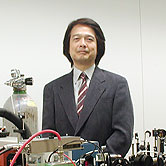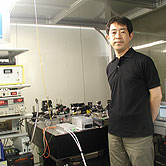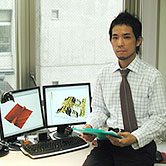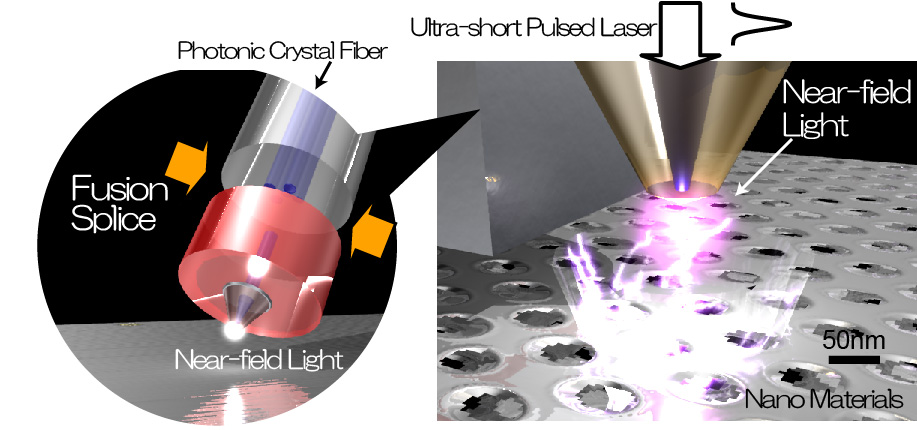| |
|

The sensing techniques of nano and micro-scale thermophysical properties are very important not only for the fundamental research of thermal engineering but also in broad cross-disciplinary fields on the basis of research and development of leading-edge technology. For example, in nanotechnology fields we need to evaluate thermal conductivity of newly developed nano-materials such as SWNT and graphene in order to design various devices utilizing these materials. In biotechnology fields it is important to control the diffusion and separation of DNA and proteins.
The aim of this research project is to develop and advance nano-micro thermophysical properties sensing techniques to accurately determine energy, momentum and mass transport properties with high spatial and time resolutions which have never been accomplished by any other conventional techniques. Furthermore, we are intending to apply those original sensing techniques for wide variety of novel engineering applications and to utilize those techniques as new tools for sensing hitherto undetected phenomena. The sensing techniques supported by optical MEMS technology can be applicable to nano and micro-level systems because they utilize physical phenomena such as near-field light confinement, interference of temperature wave, Soret effect and thermally driven capillary wave which possess inherently high spatial resolution.

Professor

YUJI NAGASAKA
Department of System Design Engineering
Faculty of Science and Technology, Keio University
Keyword of Research Area
Thermophysical Properties / Energy and Environment / Nano-micro systems
/ Functional Materials / Measurement Techniques using Laser |
Professor

TOSHIHARU SAIKI
Department of Electronics and Electrical Engineering
Faculty of Science and Technology, Keio University
Keyword of Research Area
Nanophotonics / Near-Field Scanning Optical Microscope / Semiconductor
Quantum Structure / Wavefunction Engineering / Optical Data Storage |
Associate professor

YOSHIHIRO TAGUCHI
Department of System Design Engineering
Faculty of Science and Technology, Keio University
Keyword of Research Area
Micro/Nano-scale thermal engineering / Optical MEMS
(Microelectromechanical Systems) / Micro machining |

We pursue the sophistication of 9 thermophyisical properties sensing techniques (near-field optical thermal nanoscopy (Fig.1), photothermal radiometry, laser-induced capillary wave, ripplon surface laser-light scattering, Soret forced Rayleigh scattering, periodic heat thermo-reflectance, optical MEMS viscosity sensor, optical MEMS diffusion sensor and near-field fluorescence correlation spectroscopy) in terms of (1) significant improvement of accuracy and spatial and time resolutions, (2) extension of measurement parameters and sensing applications for hitherto undetected phenomena.
 Fig. 1 Near-field Optical Thermal Nanoscopy

It is expected that the development and sophistication of these sensing techniques can contribute to quantitative evaluation of transport phenomena in nano and micro-level in wide variety of systems such as semiconductor devices, biochips, fuel cells and other small systems in which molecular transport phenomena play an important role. It is also expected that this research project will establish a new interdisciplinary field called “nano-micro thermophysical properties sensing engineering” which combines thermal engineering, chemical engineering, material engineering, measurement engineering and nano engineering.

- Oka, T., Itani, K., Taguchi, Y. and Nagasaka, Y.,” Development of Interferometric Excitation Device for Micro Optical Diffusion Sensor Using Laser-Induced Dielectrophoresis”, J. Microelectromechanical Systems, 21(2), pp. 324-330, (2012).
- Kasahara, K. and Saiki, T.,“Numerical simulation of near-field fluorescence correlation spectroscopy using a fiber probe”, J. Nanophotonics, 4, 043502/1-6, (2010).

NTL http://www.naga.sd.keio.ac.jp/
Saiki Lab http://www.saiki.elec.keio.ac.jp/ |
| |
|